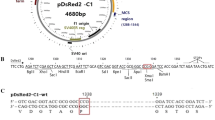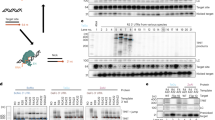Abstract
We report luciferase expression in zebrafish embryos after cytoplasmic injection of low copy numbers of plasmid DNA coupled to the SV40 T antigen nuclear localization sequence (NLS). Binding of NLS to plasmid DNA (pCMVL) occurs at room temperature in 0.25m KCl, as assayed by gel retardation at molar ratios of NLS:pCMVL of at least 100:1. Luciferase expression is induced in 35% of embryos with as low as 103 NLS-bound pCMVL copies. With 104 copies, the proportion of expression increases from 6% at 0:1 to 70% 100:1 NLS:pCMVL (p<0.01). The beneficial effect of NLS is abolished at DNA concentrations promoting high frequencies of transgene expression without NLS. Regardless of the DNA concentration, the use of NLS does not affect embryo viability for at least up to 10 days: The specificity of NLS on luciferase expression was tested by using a nuclear import deficient reverse NLS peptide (revNLS). revNLS binds to pCMVL, causing gel retardation similarly to NLS, but does not promote transgene expression. Binding of equimolar amounts of revNLS and NLS to DNA reduces by 50% the beneficial effect of NLS on transgene expression. The results suggest efficient targeting of NLS-bound plasmid DNA to the nucleus, and subsequent enhanced uptake of DNA by the nucleus. The data suggest that the use of NLS may reduce the need for using elevated DNA copy numbers in some gene transfer applications.
Similar content being viewed by others
References
Adam, S.A., Lobl, T.J., Mitchel, M.A. and Gerace, L. (1989) Identification of specific binding proteins for a nuclear location sequence.Nature 337, 276–9.
Bishop, J.O. and Smith, P. (1989) Mechanism of chromosomal integration of microinjected DNA.Mol. Biol. Med. 6, 283–98.
Brinster, R.L., Chen, H.Y., Trumbauer, M.E., Yagle, M.K. and Palmiter, R.D. (1985) Pactors affecting the efficiency of introducing foreign DNA into mice by microinjecting eggs.Proc. Natl Acad. Sci. USA 82, 4438–42.
Burns, J.C., Friedmann, T., Driever, W., Burrascanno, M. and Yee, J.K. (1993) Vesicular stomatitis virus G glycoprotein pseudotyped retroviral vectors: Concentration to very high titer and efficient gene transfer into mammalian and nonmammalian cells.Proc. Natl Acad. Sci. USA 90, 8033–7.
Culp, P., Nusslein-Vohlard, C. and Hopkins, N. (1991) Highfrequency germ-line transmission of plasmid DNA sequences injected into fertilized zebrafish eggs.Proc. Natl Acad. Sci. USA 88, 7953–7.
Fletcher, L.G. and Davies, P.L. (1991) Transgenic fish for aquaculture. In Setlow, J.K. ed.,Transgenic Fish for Aquaculture in Genetic Engineering, pp. 331–70. New York: Plenum Press.
Garcia-Bustos, J., Heitman, J. and Hall, M.N. (1991) Nuclear protein localization.Biochim. Biophys. Acta 1071, 83–101.
Gibbs, P.D.L., Peek, A. and Thorgaard, G. (1994) Anin vivo screen for the luciferase transgene in zebrafish.Mol. Mar. Biol. Biotech. 3, 307–16.
Görlich, D., Prehn, S., Laskey, R.A. and Hartmann, E. (1994) Isolation of a protein that is essential for the first step of nuclear protein import.Cell 79, 767–8.
Görlich, D., Kostka, S., Kraft, R., Dingwall, C., Laskey, R.A., Hartmann, E. and Prehn, S. (1995) Two different subunits of importing cooperate to recognize nuclear localization signals and bind them to the nuclear envelope.Curr. Biol. 5, 383–92.
Ivics, Z., Izsvak, Z., Hackett, P.B. (1993) Enhanced incorporation of transgenic DNA into zebrafish chromosomes by a retroviral integration protein.Mol. Mar. Biol. Biotech. 2(3, 162–73.
Kalderon, D., Roberts, B.L., Richardson, W.D. and Smith, A.E. (1984) A short amino acid sequence able to specify nuclear location.Cell 39, 499–509.
Kaneda, Y., Iwai, K. and Uchida, T. (1989) Increased expression of DNA cointroduced with nuclear protein in adult rat liver.Science 243, 375–8.
Kaufman, P.D. and Rio, D.C. (1991) Germline transformation ofDrosophila melanogaster by purifiedP element transposase.Nucl. Acids Res. 19, 6336–40.
Lanford, R.E., Kanda, P. and Kennedy, R.C. (1986) Induction of nuclear transport with a synthetic peptide homologous to the SV40 T antigen transport signal.Cell 46,575–82.
Lin, S., Gaiano, N., Culp, P., Burns, J.C., Friedmann, T., Yee, J.K. and Hopkins, N. (1994) Integration and germ-line transmission of a pseudotyped retroviral vector in zebrafish.Science 265, 666–9.
Meier, U.T. and Blobel, G. (1990) A nuclear localization signalbinding protein in the nucleolus.J. Cell Biol. 111, 2235–45.
Moore, M.S. and Blobel, G. (1994) A G protein involved in nucleocytoplasmic transport: the role of Ran.Trends Biochem. Sci. 19, 211–6.
Newmeyer, D.D. (1993) The nuclear pore complex and nucleocytoplasmic transport.Curr. Opin. Cell Biol. 5, 395–407.
Richardson, W.D., Roberts, B.L. and Smith, A.E. (1986) Nuclear localization signals in polyoma virus large-T.Cell 44, 77–85.
Rokkones, E., Aleström, P., Skjervold, H. and Gautvik, K.M. (1987) Microinjection and expression of a mouse metallothionein human growth hormone fusion gene in fertilized salmonid eggs.J. Comp. Physiol. 158, 751–8.
Stuart, G.W., McMurray, J.V. and Westerfield, M. (1988) Replication, integration and stable germ-line transmission of foreign sequences injected into early zebrafish embryos.Development 103, 403–12.
Stuart, G.W., Vielkind, J.R., McMurray, J.V. and Westerfield, M. (1990) Stable lines of transgenic zebrafish exhibit reproducible patterns of transgene expression.Development 109, 577–84.
Volkaert, F., Hellemans, B.A. Galbusera, P. and Ollevier, F. (1994) Replication, expression and fate of foreign DNA during embryonic and larval development of the African catfish (Clarias gariepinus).Mol. Mar. Biol. Biotech. 3(2, 57–69.
Westerfield, M., Wegner, J., Jegalian, B.G., DeRobertis, E.M. and Puschel, A. (1992) Specific activation of mammalianHox promoters in mosaic transgenic zebrafish.Genes Devel. 6, 591–8.
Wienhues, U., Hosokawa, K., Hoveler, A., Siegmann, B. and Doerfler, W. (1987) A novel method for transfection and expression of reconstituted DNA-protein complexes in eukaryotic cells.DNA 6, 81–9.
Winkler, C., Vielkind, J.R. and Schartl M. (1991) Transient expression of foreign DNA during embryonic and larval development of the medaka fish (Oryzias latipes).Mol. Gen. Genet. 226, 129–40.
Author information
Authors and Affiliations
Rights and permissions
About this article
Cite this article
Collas, P., Husebye, H. & Aleström, P. The nuclear localization sequence of the SV40 T antigen promotes transgene uptake and expression in zebrafish embryo nuclei. Transgenic Research 5, 451–458 (1996). https://doi.org/10.1007/BF01980210
Received:
Revised:
Accepted:
Issue Date:
DOI: https://doi.org/10.1007/BF01980210




